PowerSDR-IF
v1.19.35
Installation & Setup
If
you are running Vista or Windows 7, it is wise to be logged in as
Administrator, or another user with admin privileges. If you are the
only user,
this is probably the case for your normal login. PowerSDR/IF requires
.NET
Framework 3.5 SP1 (Service Pak 1). Update to this version if necessary
before
installing PowerSDR/IF. Use Add/Remove Programs in the Control Panel
(or
Programs & Features, depending on OS) to check installed version.
The
latest version can be found at Microsoft.com.
The
PowerSDR-IF v1.19.35 program can be downloaded here.
<>
Download and save the file to a convenient directory such as My Downloads. Unzip the file, and then click on the resultant folder. There should be two files in the folder… PowerSDR_Setup.msi and setup.exe. Click on either file to start installation. Note: The version referenced in the pictures you see will read v1.19.35, not v1.19.02 as shown. You will see the lower left screen. Click Next to continue. You will then see the lower right screen. If you are the only user on your PC, click on either of the choices. Accept the default installation folder and click Next.
<>
 |
 |



Click
OK and wait for the routine to finish. PowerSDR will then launch. This
is basically
what it will look like (except that the name in the title bar will read
v1.19.35).

Click on the
Setup menu in
the upper left of the program. This will open up the setup screen, as
shown
below. Most if not all of the settings will match this picture. If not,
adjust
them to match the picture. It is imperative
that
“Receive Only” be checked.

Click on the Audio tab. Adjust the entries to match the picture below. If you are using a sound card other than E-MU 0202, go to the Sound Card page for help with installing your sound card, then return here.

Click OK to close the setup window.<> Click on the SetupIF menu at the top of the main PowerSDR screen. This will open the rig interface setup screen…
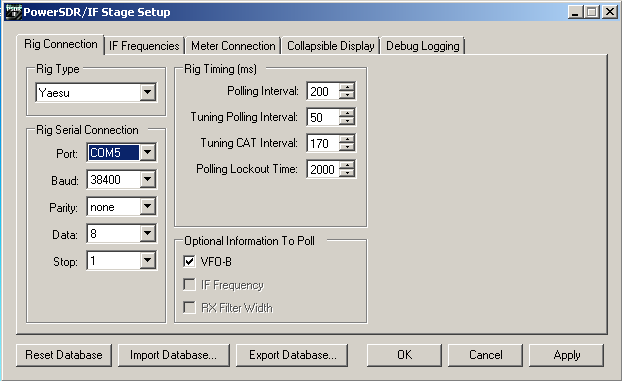
Select rig type to match your rig.
Choices include K3, Yaesu (FT950/2000/5000), TS940S, TS950S and HRD.
The HRD choice assumes that HRD is connected to the rig and provides a
DDE link to HRD. This choice provides an wasy way to connect to rigs
that are not directly supported. Set
port number to match the port that your rig is connected to unless you
are connecting though HRD. This can
be a real serial port, a
USB-to-serial adapter or a virtual port such as those created by
LP-Bridge, LPB2 or microHam
Router. It is smart to get PowerSDR/IF working
directly with your rig before trying it through LP-Bridge or LPB2. Set
baud rate to the fastest that your rig supports, and set your rig to
match. Leave other
settings
at their defaults. If your rig is a K3, you have the option of syncing
the RX Filter
width in PowerSDR/IF with the K3. This feature has some limitations,
and you may not like
it. With a K3, it is normal to also poll for IF Frequency, which makes
mode offset tracking automatic.
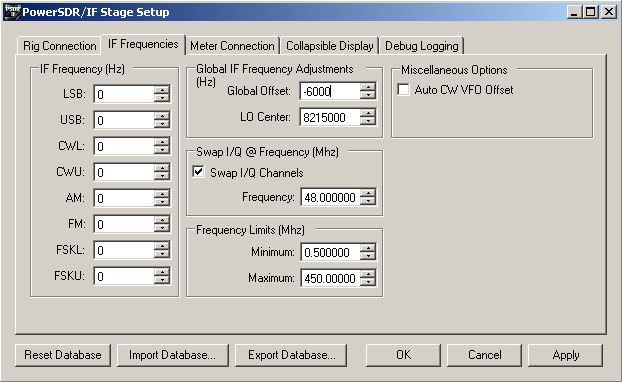
Below is the screen for Yaesu. Remember, the audio cables need to be swapped for FT-950 / FT-2000 because the IF-2000 converter board reverses the sidebands. CW and FSK values depend on CW pitch and RTTY shift settings in the rig. Typical values are shown. Global Offset on recent LP-PANs will be near -6000 for most rigs, -7500 for Orion. Older models may need a larger value. Once again, this has to be fine tuned. Since only the K3 reports actual mode offsets, you will need to enter values for other rigs. The values below should be close, but have to be fine tuned if you wish to listen to PowerSDR/IF and the rig's audio at the same time and have the pitch match. Swap I/Q should only be enabled for K2 & K3, which reverses IF injection on some bands. If you are using a transverter with your rig, set the maximum frequency limit to the highest frequency you will use, for instance 148.000 MHz or 470.000 MHz.
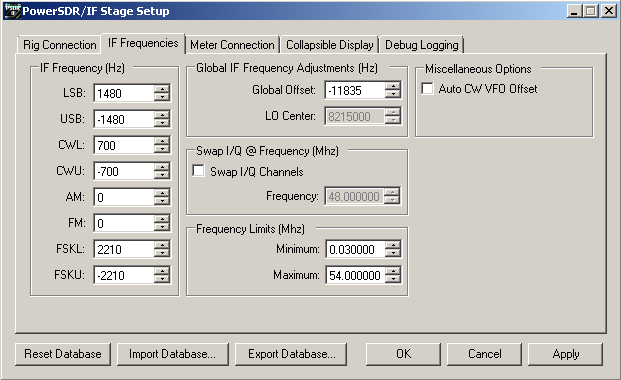
Click on Collapsible
Display
tab. Collapsible Display is a new feature that allows the user to fill
the
PowerSDR window with the panadapter (or waterfall or Panafall),
covering up all
the extraneous buttons and controls. Additional controls can be “added
back”
into the display as desired. Check the additional items that you want
displayed
whenever displaying collapsed view. Click OK to close the
window.

Click Start in the
upper left corner of PowerSDR/IF. You should now see
the K3 VFO
frequencies in PowerSDR/IF, and you should see signals in the
panadapter,
as shown
below. The display defaults to the “fill” style, where the graph is
filled down
to the noise floor. This can be changed to the style shown by going to
the
Setup>Display tab and un-clicking the “Fill” selection. If you have
speakers
connected to the E-MU, you should also hear sound from them. If not,
check to
see if the Mute button is lit in PowerSDR/IF. If it is, click on it to
un-mute.
Listening to PowerSDR/IF is of course optional. It can be used solely
as a
panadapter display and interface if you choose.

Setup for Rigs Without CAT Interface
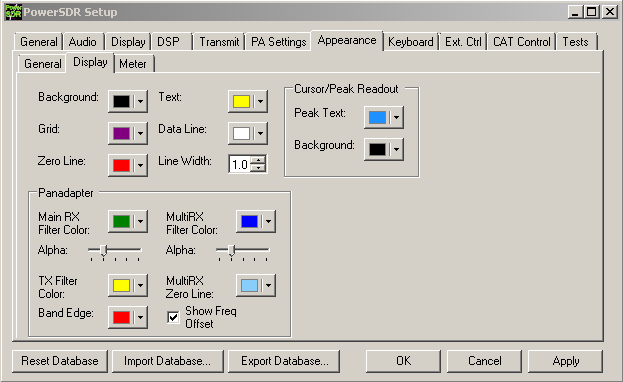
To
display a relative frequency scale instead of actual rig frequency,
check the
“Show Freq Offset” box in the PowerSDR Setup tab depicted above. The
resulting
display will appear as shown below. Tuning the rig will cause the
signals to
shift. The red line represents the center of the IF passband, ie.
frequency the
rig is tuned to.
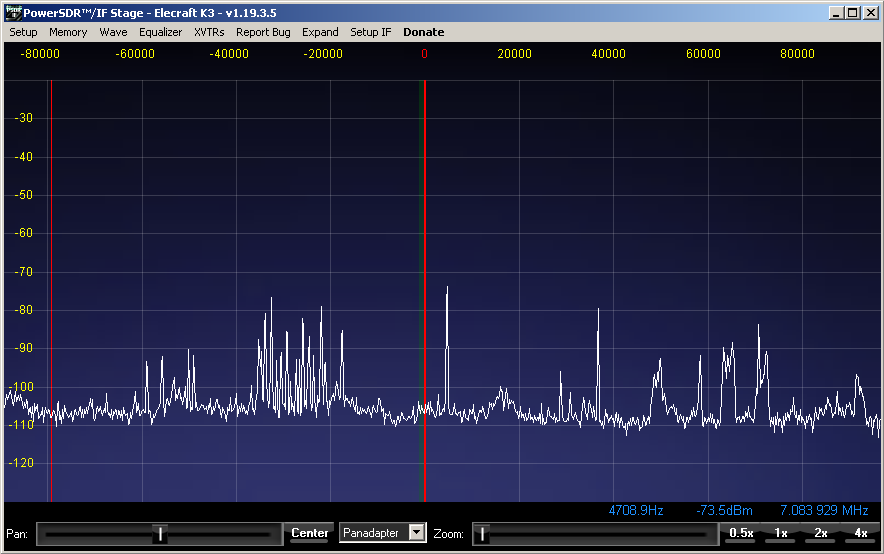
PowerSDR-IF
v1.19.35 Collapsed View


Below is the normal (Expanded) PowerSDR/IF Stage display. We have added
color box
overlays to
help identify the various control sections. The sub-receiver is
activated in
this picture. Your view may be slightly different, depending on how you
size
the window. PowerSDR-IF can be sized from 1024x768 up to the full
screen
resolution of you monitor. As you zoom up the window, the pan display
becomes a
larger percentage of the window. Most of the receive controls are
active for
LP-PAN use. The transmit controls only work with FlexRadio hardware.

PowerSDR/IF
Stage provides several ways of tuning, and supports both VFO A and VFO
B of the
K3.
Tuning
of VFO A can be accomplished in these ways…
-
Using the tuning knob on the K3
-
Clicking and dragging the pan display for
large excursions
-
Using the mousewheel for fine tuning. The
tuning step size is set in the box between VFO A and VFO at the top of
the
program.
-
Point-and-click
is invoked by right-clicking in the pan display to
activate a yellow cursor. Position the cursor over a signal and
left-click to
tune to the signal.
-
Enter
a frequency directly into the VFO A window
Tuning
of VFO A can be accomplished in these ways…
-
Using the VFO B tuning knob on the K3
-
Clicking and dragging the blue sub-RX
passband and dragging it
-
Using
the mousewheel for fine tuning. The tuning step size is set in
the box between VFO A and VFO at the top of the program. Hold Ctrl
while using
the mousewheel to tune VFO B
-
Point-and-click
is invoked by right-clicking twice in the pan display
to activate a red cursor. Position the cursor over a signal and
left-click to
tune VFO B to the signal. When the red cursors are on, mousewheel
tuning
adjusts VFO B.
-
Enter
a frequency directly into the VFO B window
Here
is a summary of the various controls that are supported in this version
of
PowerSDR, referenced to their location on the screen.
PURPLE SECTION
VFO Lock... Prevents the VFOs from being changed.
Tune Step... Sets the step size for mousewheel tuning and point/click accuracy.
Save/Restore... Saves the current frequency for later recall.
| RED SECTION |
X2TR… Not used
Red Dot, Green Arrow…Controls the sound recorder. Clicking on the
red
dot starts recording of the entire panadapter passband. Clicking on the
green
arrow allows playback. During playback, you can tune around anywhere in
the
recorded passband.
AF…Controls
overall audio monitor level
AGC-T… Sets the AGC threshold
Drive… Not used
AGC/Preamp… Sets AGC speed and preamp setting, only for
PowerSDR. If you set up
the Aux CAT interface in LP-Bridge, the preamp setting will follow the
K3
Squelch… Adjusts squelch… mainly useful for FM, but
active in all modes.
BCI rejection… Not used
| YELLOW SECTION |
Split / A>B / A<B / A<>B… Self explanatory. Other
controls in this group are not implemented.
| BLUE SECTION |
NR…
Digital Noise Reduction (PowerSDR Only)
ANF…
Automatic Notch Filter (PowerSDR Only)
NB, NB2… Digital Noise Blankers (PowerSDR Only)
SR, BIN… Not used
Display Selector… Determines what is displayed in the graph
window. Choices are
Panadapter, Scope, Phase, Spectrum, Waterfall, PanaFall (PowerSDR Only)
AVG / PEAK… Provide averaging or peak hold behavior for
the signals in the
panadapter. Settings are on the Display tab in Setup. (PowerSDR Only)
MultiRX / Swap… Controls the sub-receiver (PowerSDR Only).
Sliders determine the
routing and mixing of audio from the main and sub-receiver. When Sub RX
is on,
there are two passbands displayed… green for main and blue for sub.
Green
passband is linked to VFOA and blue is linked to VFOB.
| WHITE SECTION |
Mode
Specific Controls… Panel
changes depending on Mode setting.
CW Pitch… The most important control is CW Pitch,
which only appears when a CW
Mode is selected. Set to match your K3 CW Pitch setting.
Show TXCW Frequency…When CW mode is selected, checking the "Show
TXCW Frequency" box places a vertical yellow line on the tuned
frequency. This is particularly helpful
when working split and looking for an open frequency in a CW pileup.
| GREEN SECTION |
Band…
Selects band for both
PowerSDR and K3. This can be used as a quick way to change bands.
Mode…
Selects mode for both
PowerSDR and K3. Modes not supported in K3 are ignored by K3. Modes
such as DRM
require additional software to decode. SAM is Synchronous AM mode.
Filter…
Selects PowerSDR DSP filters
in both PowerSDR and K3, unless filter syncing is disabled in
SetupIF>IF
Frequencies.
Width and Shift…
Follow passband indicator on
the pan display. If you checked the “RX Filter Width” box in SetupIF,
the Width
will synchronize with the DSP settings on the K3, regardless of whether
changes
are made in PowerSDR or the K3. But there are limitations to the use of
this,
since Shift cannot be linked. This can cause erratic behavior,
especially if
you try to adjust the lower side of the passband. You can temporarily
disable
the link by clicking on “Var2”, or permanently disable it in SetupIF.
| ORANGE SECTION |
RX Meter… allows several different modes for the S-Meter to be selected
| TURQUOISE SECTION |
Pan & Zoom…
adjusts the portion of the
passband that is displayed in the panadapter. Wide display is far left
in zoom
bar, PAN should be centered.
| TOOLBAR |
In
addition to the highlighted areas, there are several other controls
which are
useful. They are accessed in the toolbar at the top of the program.
RX EQ…
enables graphic equalizer
for PowerSDR receiver. The equalizer can be set in the Equalizer pull
down menu
at the top of the program.
Memory… save popular frequencies for recall.
DONATE… Please consider a donation to Scott and Chad
for their hard work in
customizing PowerSDR/IF for use with LP-PAN!
Expand/Collapse… Toggle between the Expanded (original) view
and the Collapsed
(uncluttered) view.
Calibration...
To set the gain display accuracy requires a signal source with known output level. This can come from a calibrated signal generator, or something as simple as the Elecraft XG1, XG2 or XG3 test oscillators. This section assumes an XG2 is being used, which has an output of about –73dBm (50uV / S9). Set the K3 preamp and attenuator OFF, and the Preamp setting in PowerSDR to MED. Turn Avg. on in PowerSDR. Connect your generator to the RX ANT input of the K3, and select RX ANT. Adjust your sound card inputs to about 40% of full gain. If you are using the E-MU 0202, set the pots to about the 10 or 11 o’clock position. In all cases, the left and right level controls should be set exactly the same. Most software based controls are “ganged” so that they can be adjusted together. Adjust R29 on LP-PAN to mid scale. These settings should work well for most users. If you find that you need less gain to avoid overload by strong signals, you can turn down the sound card inputs or the LP-PAN gain. If you need more sensitivity, you can increase the sound card inputs, or better still, install the K3 IF buffer mod (available from Elecraft) and/or the LP-PAN preamp. Tune in the XG2 signal at 3.579, 7.040 or 14.060 MHz. The peak on the pan display should be –73dBm. If it’s not, PowerSDR can be calibrated to display the correct level easily.
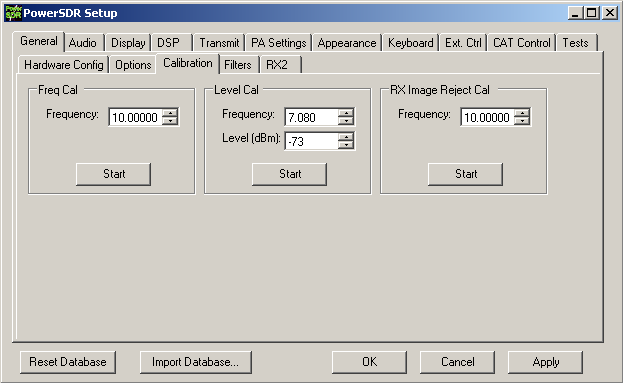
Click on Setup in PowerSDR, then click on the Calibration tab on the second row of tabs. Enter the XG2's frequency in the Frequency box of the Level Cal window. Enter –73 in the Level box. Click Start to perform the calibration. When calibration is finished, close the Setup window. The signal peak should now be –73dBm. If you make any changes in the future, such as a change in sound card input level or the addition of the K3 IF buffer mod, you can rerun the calibration.
If you have an adjustable signal generator, you can set the maximum signal that LP-PAN can handle without clipping. A good compromise between weak signal display and maximum signal handling is a clipping point of about –10 dBm with the K3 preamp OFF. You will need to jockey the sound card and R29 settings to find the best compromise.
Global Offset and Mode offset adjustments –
Refer back to SetupIF pictures of the IF Frequencies tab. If your rig is a K3, all the mode offsets should be set to 0. LP-Bridge provides an offset value to PowerSDR which keeps the IF center frequency of PowerSDR synchronized with the K3. For other rigs, set the starting mode offset values as indicated. It is important that AM be set to 0.
Due to intentional offset of the local oscillator of LP-PAN, and slight variations in the xtals, you must fine tune the software to exactly line it up with the rig. This is done with the Global Offset control. The nominal offset will be 6kHz with newer LP-PANs, but earlier models had various offsets before we standardized on 6kHz. This was done to move the center of the passband slightly to avoid problems with some older or cheaper sound cards which have difficulty near an audio frequency of 0 Hz. On earlier K3 models without the additional offset, the nominal value will be 0. Global Offset is set in the PowerSDR SetupIF window.
Set your rig to AM mode and tune in an AM signal on a known frequency, like WWV. Zoom the PowerSDR/IF display in all the way. Adjust the Global Offset so that the carrier is centered on the red line in the middle of the display. This is all that is necessary for the K3.
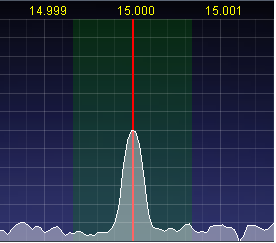
To fine tune the individual mode offsets for other rigs, set the rig to the mode to be adjusted and tune in a carrier for a comfortable pitch. Turn the volume of the sound card monitor up so that you hear the output of PowerSDR at about the same level as the rig. The two tones should be similar, but probably not exactly the same pitch. Adjust the IF Frequency control for each mode to zero beat the tones. Note: Any IF shift or DSP shift controls in the rig will affect the pitch, so make sure that the rig controls are centered when making the adjustments.